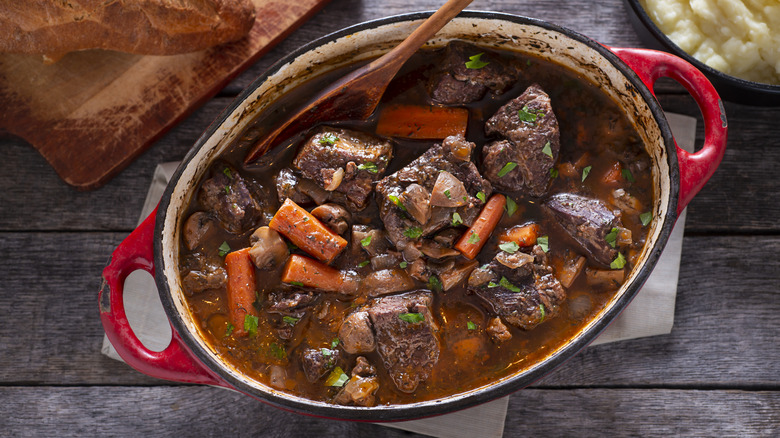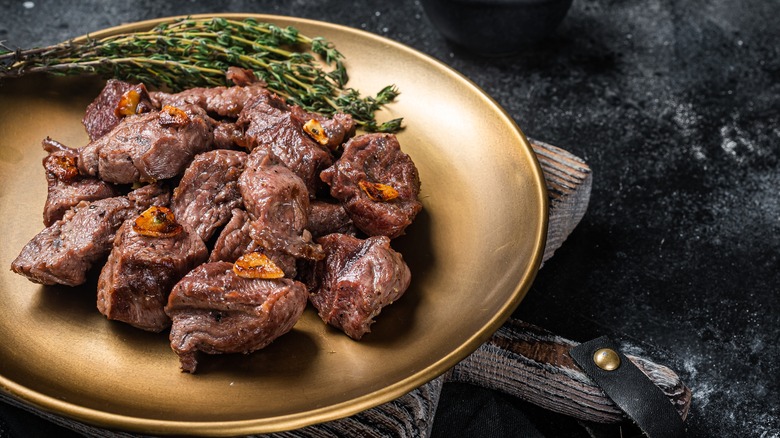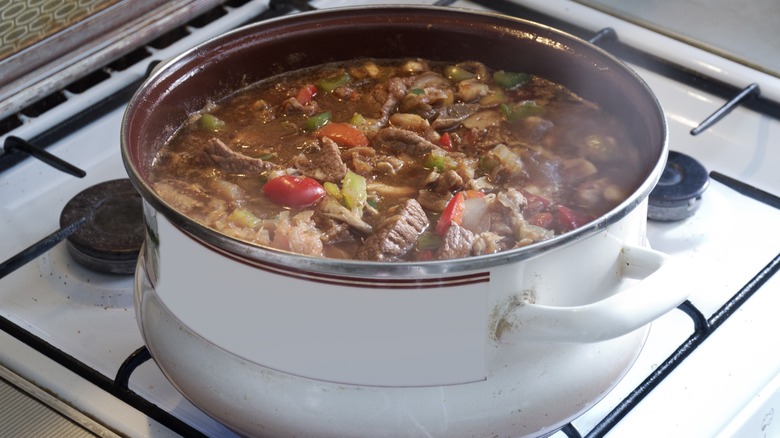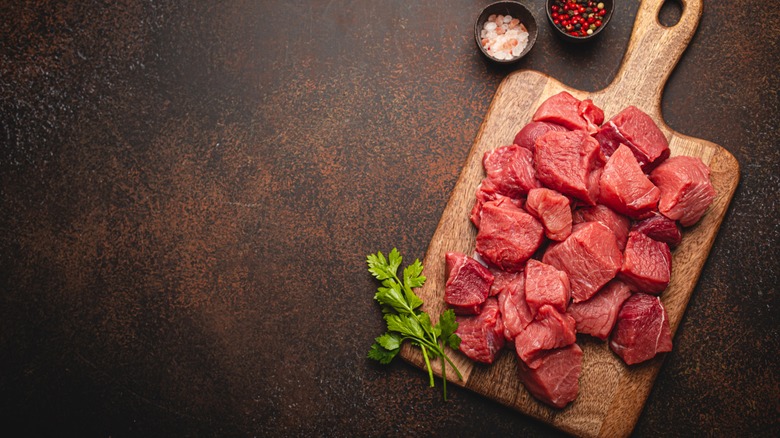The Science Behind Why Your Stew Meat Is Turning Out Dry
Slow-braised or stewed meat should be juicy, unctuous, and tender in your mouth. You've been simmering that beef stew for hours, and you take a bite into what should be a perfect mouthful. Your face falls. Why is your meat, sitting there in a very wet stew, so dry it sucks the moisture out of your mouth?
There are two common issues that could cause your stew meat to turn out dry and unsatisfying. The first is that you may be crowding the meat in the browning stage. Even if it seems like way too much work (we've all been there), there's a reason that recipes tell you to brown your meat in batches. Before you make stew, you want to get that good, brown crust on your meat for richer flavor in your soup. To actually get good results, you can't crowd your stew chunks.
Overcrowding meat lowers the temperature enough for the moisture to sit and boil the meat, capping the cooking temperature at 212 degrees. Too much moisture is exuded, and because of the lower temperatures, it can't evaporate quickly enough. The Maillard reaction, which causes browning, starts to happen when the surface of the meat reaches roughly 300 degrees Fahrenheit — something that can't happen when it's steaming in its own juices. In order to achieve browning, that liquid must boil off; however, this takes time, which, in turn, prevents browning and boils the meat.
How temperature affects moisture loss
Protein bundles in muscle hold moisture. As the meat cooks, the proteins denature and contract; this squeezes out moisture. Cooking meat at high heat causes protein bundles to shrink a lot more — tests completed by Cook's Illustrated show that meat roasted at high temperatures leads to a moisture loss of 25% versus low heat, which led to only a loss of 9.25%.
When searing meat to brown it, you're only supposed to affect the very outside of the cut. High heat and moving quickly achieve this. The longer the meat sits in the pan to brown, the more the whole chunk is subjected to higher heat, causing more moisture loss. What you want, instead, is a brown crust and an interior as raw as it can be so it can cook at a lower temperature during stewing, retaining more moisture. If your pan is overcrowded during the browning process, it's a domino effect. The meat releases too much moisture, the moisture can't evaporate, the meat can't brown, and the meat cooks while you're trying to brown it at a high temp rather than while you're stewing it slowly.
But it's not all about moisture loss
The other thing that could be leading to dry stew meat is that you're — get this — stewing it way too long. "Juiciness" is a subjective measure, but it's generally influenced by the viscosity of liquid and how much saliva your mouth produces when you chew. As the beef cooks over time at a low temperature, the connective tissue gelatinizes, creating a viscous mouthfeel. As it mixes with the moisture in the meat, the fat coats the tongue and makes your mouth water. These things all create what you'd call juiciness.
You need both gelatinized collagen and moisture to achieve juiciness. Through a series of tests, J. Kenji López-Alt of The Food Lab discovered that the best cooking time for stew beef at 190 degrees Fahrenheit is between two and three and a half hours. This happy spot means the beef chunks have started converting connective tissue into gelatin to tenderize but stay together rather than shredding. Too far beyond that, and the meat disintegrates, losing all of its gelatin and moisture — becoming stringy and dry. He noted that even though the meat stewed for three hours for five hours had roughly the same amount of moisture loss, the five-hour beef had a dryer mouthfeel because it had lost its gelatinization.
A better method
To achieve perfectly tender, juicy stew meat, you have two options for browning. You can either start with already cubed chunks, or you can start with a fully intact roast, whether that's a chuck roast, brisket, or beef cheeks. If you begin with pre-cubed pieces, sear them in batches. If you notice moisture hanging around in your pan, remove some of the chunks — the pan is too crowded. If necessary, pour off the liquid in the pan (you can add it to the stew broth later or deglaze the pan with it).
The other alternative is to brown the whole roast and then cut it up. You'll have less surface area browned once the meat is cubed, but there will still be plenty of browning to achieve the depth of flavor you're going for. Since less of the meat will have been exposed to high heat because of its density and lack of surface area, the meat will retain much more of its moisture for slow cooking.
Then, importantly, monitor the voracity of temperature and the length of time you cook the stew. A simmer is achieved between 185 and 205 degrees. Too hot, and you're boiling your meat, which will dry it out. While an "all-day simmer" might sound like a romantic move, you now know that it should only simmer for three hours. These little changes to your process will lead to perfectly tender, juicy stew meat.



